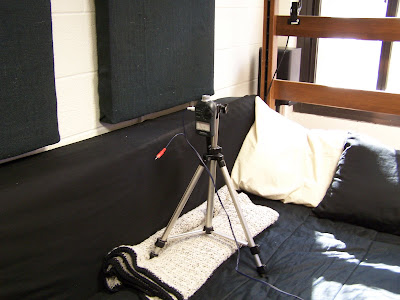
Another post, and some more new toys to play with. I recently got an external USB sound card (Behringer UCA-202) and an extra long RCA cable so I could play around with some room measurements. The main reasoning behind the external sound card was cabling issues, and also to add a second output so I could drive either my
desktop speakers or my main 5.1 setup with a signal from my computer. Cabling-wise, my laptop's internal card only has two 3.5mm stereo jacks (one for mic/line in and one for output), which meant that I would need an RCA adapter for each one. With the sound card there are left and right RCA plugs for both the input and output, which makes hookup a little simpler with cables that are A) more versatile and B) already in my possession.
Before I get into the measurement process I'll go ahead and give a brief answer to the question you might have: "What are you measuring, and why?" At the most basic level, this process measures sound level. However, the purpose of this exercise is not to determine how loud I can play back the Death Star explosion (louder than is comfortable, if you were wondering), but to see how accurate that sound reproduction is. Accuracy can be determined by comparing the relative sound levels of all of the frequencies from 20Hz to 20Khz (the audible range). An ideal system would output the exact same sound level for every frequency over that entire range, but due to speaker characteristics and room interactions that is not the case. The purpose of measuring the frequency response is to see what is happening with the frequency response so that equalization can be applied, or to determine if components need to be moved to achieve a more even output.
As I write this, I see that I'm beginning to stretch the definition of brevity, so I'll leave that explanation as it is and have a future post dedicated to my opinion of the characteristics of an good audio system and the challenges we're faced with in trying to obtain it.
Now, onto the measurements. For these measurements I'm using some free software called
Room EQ Wizard (REW). It works by playing frequencies over a range that you choose (through your speakers) and simultaneously measuring the sound level at each frequency (through a microphone or Sound Pressure Level (SPL) meter). It then plots the sound level as a function of the frequency, giving you the combined frequency response of your speakers and the room. For these measurements I'm using a Radio Shack Analog SPL meter, which isn't very reliable above about 3KHz, so I'm just going to be measuring my subwoofer.
The first step of the process is to calibrate the sound card. To do this, I fed the output of the sound card directly back into the input and made a measurement from 0Hz to above 20Khz. I don't have the original graph, but it looked similar to this one with better extension below 10Hz.
From there, REW created a calibration file which cuts or boosts certain frequencies to achieve a flat curve. This way, the sound card has no (read: negligible) effect on the final measurements. Here's the calibrated response of my sound card:
After the sound card calibration I was ready to start measuring. I hooked up the SPL meter to the input on the sound card, and the output of the sound card to the AV receiver that drives my subwoofer.
You may notice that there are a couple of unconnected banana plugs sitting in the picture below. I disconnected the main left and right speakers so I would only get the output from the subwoofer.
Next I set up a measurement in REW to sweep from 15Hz to about 150Hz, and this is the result:

The line at 75dB is the level of the signal that was fed to the speaker, and as you can see, that's not exactly where the output ended up. I have the subwoofer crossed over at 80Hz, (that's when the left and right speakers take over) which explains the steep rolloff on the upper end. On the bottom end, I start to lose usable output around the low 30's. The speaker is rated from 24Hz to 200Hz, which means I either have a pretty brutal room mode in that area, or the published values are pretty optimistic (or both). The other large peaks and dips are all due to room modes, or resonances in the room which are a function of the room dimensions as well as speaker and listening positions. There are some pretty low dips at 40Hz and 50Hz. For those of you unfamiliar with a decibel scale, -3dB equates to about half of the original power, while -10dB is about 1/10th. In terms of perceived loudness, -10dB is about half as loud, which is a huge difference over such a small range. I'll be playing around with my subwoofer placement in the future to try to mitigate some of these modes.














